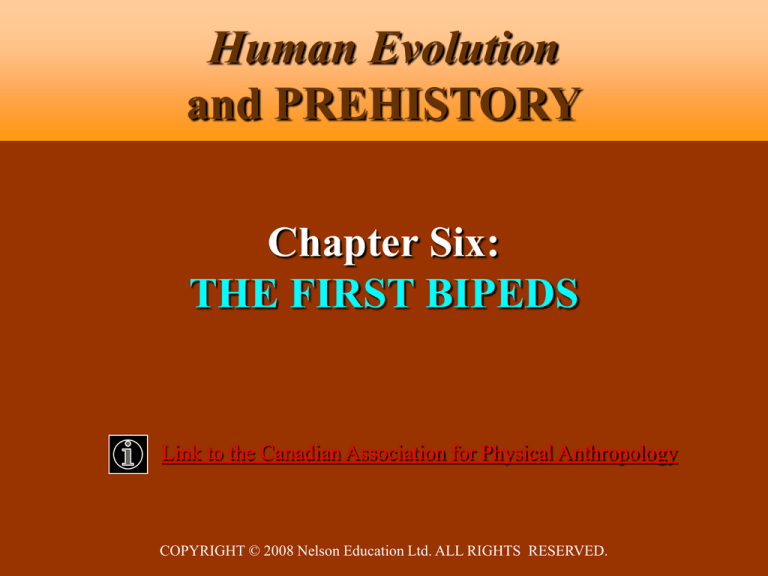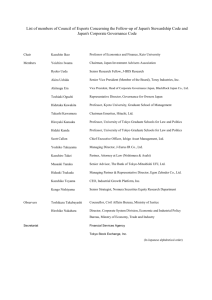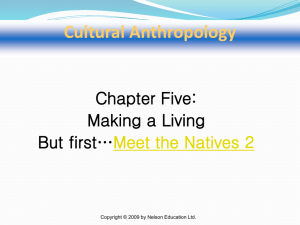
Human Evolution
and PREHISTORY
Chapter Six:
THE FIRST BIPEDS
Link to the Canadian Association for Physical Anthropology
COPYRIGHT © 2008 Nelson Education Ltd. ALL RIGHTS RESERVED.
Chapter Preview
What is the Anatomy of Bipedalism and How is it
Preserved in the Fossil Record?
Who Were the Australopithecines and What Were
They Like?
Why Had Australopithecus Become A Bipedal
Walker?
COPYRIGHT © 2008 Nelson Education Ltd. ALL RIGHTS RESERVED.
THE ANATOMY OF
BIPEDALISM
Shared derived characteristics distinguishing hominins
from the other African apes
Position of foramen magnum is more forward
S-shaped spinal column
Wide and foreshortened pelvis
“kneeing-in” of thigh bones (femora)
Stable arched foot and absent opposable big toe
Shorter toes
COPYRIGHT © 2008 Nelson Education Ltd. ALL RIGHTS RESERVED.
THE ANATOMY OF
BIPEDALISM
COPYRIGHT © 2008 Nelson Education Ltd. ALL RIGHTS RESERVED.
THE ANATOMY OF
BIPEDALISM
COPYRIGHT © 2008 Nelson Education Ltd. ALL RIGHTS RESERVED.
Australopithecus
a well-known hominin
that lived between 4.2
and 1 mya in East and
South Africa
Bipedal when on the
ground
Apelike brain
COPYRIGHT © 2008 Nelson Education Ltd. ALL RIGHTS RESERVED.
Australopithecus
COPYRIGHT © 2008 Nelson Education Ltd. ALL RIGHTS RESERVED.
Early hominins
COPYRIGHT © 2008 Nelson Education Ltd. ALL RIGHTS RESERVED.
Gracile Australopithecines
3.9 to 2 mya in East Africa
3.5 to 2.3 mya in South Africa
Erect bipeds, about 1-1.5 m. in stature
Apelike skull morphology
Teeth for chewing food in a hominin fashion
COPYRIGHT © 2008 Nelson Education Ltd. ALL RIGHTS RESERVED.
Gracile Australopithecines
Earlier fossils show dental features similar to some
late Miocene apes; later South African fossils do not
Sexually dimorphic, in body size and canine tooth
size
COPYRIGHT © 2008 Nelson Education Ltd. ALL RIGHTS RESERVED.
Gracile Australopithecines
Foramen magnum is forward and downwardlooking, as in genus Homo
Brain is about a third of a modern human brain in
size, and three times larger than Miocene apes
Endocasts suggest that the human cerebral
reorganization has not yet occurred
Blood drainage system for the brain is significantly
different from genus Homo
COPYRIGHT © 2008 Nelson Education Ltd. ALL RIGHTS RESERVED.
Australopithecines
Two indisputable facts:
1. Retention of some form of
adaptation to arboreal life
2.
Evolution of erect bipedal
position long before
acquiring highly enlarged
brain
COPYRIGHT © 2008 Nelson Education Ltd. ALL RIGHTS RESERVED.
Robust Australopithecines
South Africa
1.8 to 1 million years ago
Thick bones for their size,
with prominent muscle
markings
Sagittal crest, for huge
temporal muscles (more
evident in males) – an
example of convergent
evolution in gorillas and
hominins
COPYRIGHT © 2008 Nelson Education Ltd. ALL RIGHTS RESERVED.
Robust Australopithecines
East Africa
2.5 to 1.3 million years ago
More massive skull and larger body size than
South African relatives
Enormous molars, premolars, mandible and
palate
COPYRIGHT © 2008 Nelson Education Ltd. ALL RIGHTS RESERVED.
Gracile-Robust Relationship
East African robust forms likely evolved from earlier
gracile forms in east Africa
In South Africa the robusts were either an offshoot of the
East African lineage, or convergent evolution from a
South African ancestor
COPYRIGHT © 2008 Nelson Education Ltd. ALL RIGHTS RESERVED.
Robust-Homo Relationship
Robust australopithecines had evolved into highly
efficient and specialized consumers of plant food
Many anthropologists believe this allowed early
Homo and robust australopithecines to co-exist for
1.5 million years because they avoided competition
for the same ecological niche
** law of competitive exclusion
COPYRIGHT © 2008 Nelson Education Ltd. ALL RIGHTS RESERVED.
AUSTRALOPITHECINE
PREDECESSORS
Sahelanthropus tchadensis (Chad)
7-6 mya
Small canines and humanlike face
Probably bipedal
Recent 3D reconstruction confirms it is more
closely related to hominins
Likely close to common ancestor
COPYRIGHT © 2008 Nelson Education Ltd. ALL RIGHTS RESERVED.
AUSTRALOPITHECINE
PREDECESSORS
Orrorin tugenensis (east Africa)
6 mya
13 fragments of lower jaw, teeth, thigh bones
Molars are thickly enameled like
Australopithecines, but smaller
Suggestion of bipedalism
Uncertain evolutionary relationship
COPYRIGHT © 2008 Nelson Education Ltd. ALL RIGHTS RESERVED.
AUSTRALOPITHECINE
PREDECESSORS
Ardipithecus (east Africa)
5.8 to 4.4 mya
Sp. kadabba and ramidus
Likely bipedal when on the ground
Mixture of ape and hominin dental features
Forested environment
COPYRIGHT © 2008 Nelson Education Ltd. ALL RIGHTS RESERVED.
AUSTRALOPITHECINE
PREDECESSORS
Kenyanthropus platyops (east Africa)
Contemporary with early east African
australopithecines
Maeve Leakey sees her fossil as ancestral to
the genus Homo
COPYRIGHT © 2008 Nelson Education Ltd. ALL RIGHTS RESERVED.
AUSTRALOPITHECINE
PREDECESSORS
Relationship to Hominins
Current evidence indicates that hominins evolved from late
Miocene apes, becoming distinct about 5 mya
More than one bipedal model emerged from this new primate
niche; one of them was Australopithecus
Are any of these predecessors ancestral to the
australopithecines or to chimpanzees, or did they become
extinct?
Pattern in early hominin evolution has been short periods of
change, marked by prolonged periods of stasis
COPYRIGHT © 2008 Nelson Education Ltd. ALL RIGHTS RESERVED.
ENVIRONMENT, DIET, AND
AUSTRALOPITHECINE ORIGINS
Major climatic changes in the late Miocene:
Drying up of the Mediterranean Sea
Breaking up of forests
Creation of a mosaic environment with more
open areas, interspersed with forest patches
COPYRIGHT © 2008 Nelson Education Ltd. ALL RIGHTS RESERVED.
Effect of Climatic Change
1. Change in diet
- less “tree” food
- more open ground foraging, e.g. seeds,
grasses, roots
2. Change in dentition
- smaller canine teeth
- male canines became as small as those of
females
COPYRIGHT © 2008 Nelson Education Ltd. ALL RIGHTS RESERVED.
Australopithecines and Tools
No evidence of toolmaking clearly associated with
Australopithecines, although hands of later
Australopithecines were suitable
Could Australopithecus have been a tool-user and
maker of simple tools such as bonobos and
chimpanzees today?
They could have used wooden tools, convenient
stones, animal bones
COPYRIGHT © 2008 Nelson Education Ltd. ALL RIGHTS RESERVED.
HUMAN BIPEDALISM
Disadvantages
More visible to predators
Exposes soft underbelly
Interferes with ability to change direction instantly while
running
Not a fast locomotion method
Frequent lower back problems and circulatory problems
Serious impediment if one leg is injured
** all of these disadvantages placed our early hominin ancestors
at risk
COPYRIGHT © 2008 Nelson Education Ltd. ALL RIGHTS RESERVED.
HUMAN BIPEDALISM
How did bipedalism become a viable adaptation?
Possible selective pressures:
1. Males gather and transport food to females, who were
restricted by dependency of offspring
2. Nonterritorial, far-ranging scavenging, because a biped is
able to travel long distances without tiring
3. To cope with heat stress out in the open
COPYRIGHT © 2008 Nelson Education Ltd. ALL RIGHTS RESERVED.
ORIGINAL STUDY
The Naked and the Bipedal
Upright stance greatly reduces the amount of the body’s
surface area that is directly exposed to the sun and increases
the amount exposed to the cooler breezes a few feet above the
ground
Hair loss helps to lose more body heat
The “naked biped” becomes an adaptation to the heat of the
savanna by keeping the brain cool and allowing for its
expansion
COPYRIGHT © 2008 Nelson Education Ltd. ALL RIGHTS RESERVED.
HUMAN BIPEDALISM
4. Bipedalism is far more economical than
quadrupedal locomotion at walking speed
The causes of bipedalism are likely to be multiple
e.g. food transport AND carrying infants AND
reaching for food AND seeing predators AND
using hands as protection
COPYRIGHT © 2008 Nelson Education Ltd. ALL RIGHTS RESERVED.
NEXT TIME:
Homo habilis and Cultural
Origins
COPYRIGHT © 2008 Nelson Education Ltd. ALL RIGHTS RESERVED.









